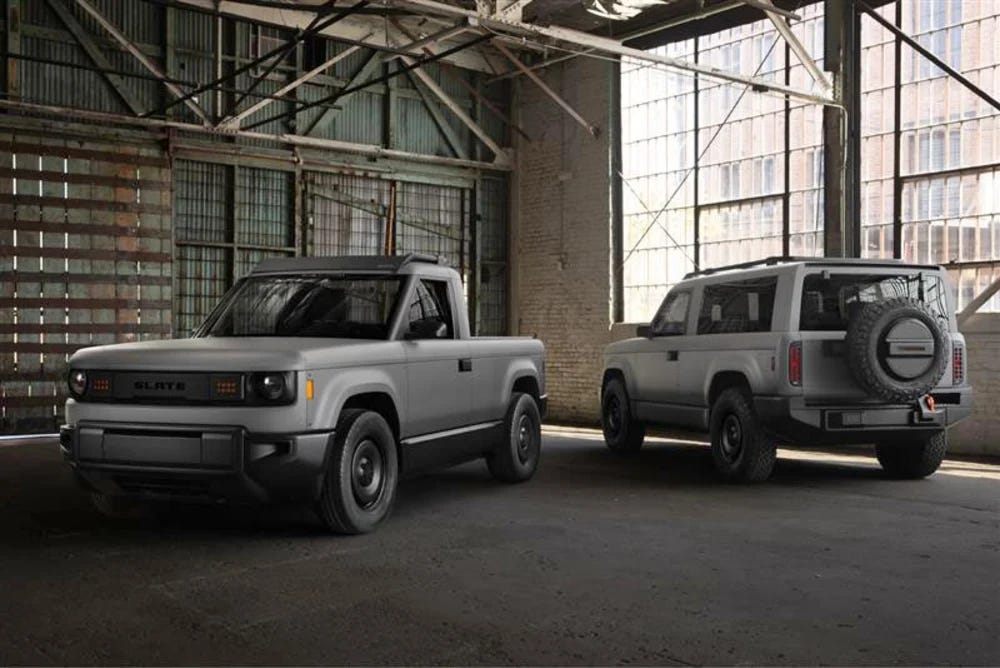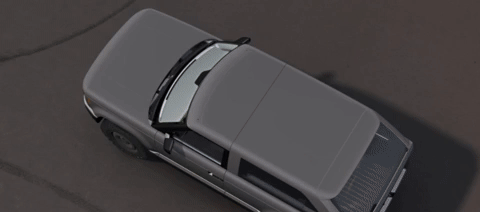Challenger Chronicles: Tesla Down, Slate Up
Unveiling the Disruptors—How Nimble Brands Redefine the Road Ahead
The car industry loves to talk about the future—meanwhile, it’s stuck rehashing the past. Overpriced. Over-teched. Overhyped. Still designed for the few, not the many.
Then comes Slate—the anti-Tesla, pro-DIY, no-bullshit EV startup building electric trucks that are affordable, customizable, and actually useful.
Welcome to "Challenger Chronicles," where we spotlight brands like Slate that aren’t just rewriting the rules-they’re torching the old playbook and handing the pen to the next generation.
The Hook: Build the EV for the Rest of Us
Slate isn’t a vaporware dream from Silicon Valley—it’s a Midwest-built, Bezos-backed, $25K electric truck you can actually buy (soon), actually fix, and actually make your own.
Forget glossy paint jobs and spaceship interiors. The "Blank Slate" truck is raw utility: composite panels, wind-up windows, no screens, and 100+ plug-and-play accessories that turn this rig into a one-seat hauler or a five-seat SUV—your choice.
The Odds: My DIY Truck vs. Your $500B Industry
Most EV startups crash into reality. Slate’s skipping the hype and channeling Model T energy—make it simple, durable, and cheap enough to be your first car, not your flex purchase.
How? One color. No touchscreen. Manual everything.
Punk rock minimalism meets working-class pragmatism.
The result? A $25K EV pickup with 150–240 miles of range, no frills, and no apology.
The Differentiator: Affordability x Customization x Analog Cool
Slate isn’t trying to turn your car into a rolling iPhone. It’s doing the opposite.
Manual windows. No center screen.
Snap-on upgrades. Tool-free customizations.
A truck that’s meant to be changed—not just charged.
This isn’t just a product. It’s a platform for creativity, pride of ownership, and fixing stuff yourself.
Watch this video…
Strategies and Actions: How Slate’s Playing to Win
1. Transparency, Front and Center
No smoke, no mirrors. Clear pricing, honest specs, and real timelines.
2. Radical Simplicity
Slate skips the paint booth and touchscreen arms race. One model. One color. One purpose: keep costs down and value up.
3. Customization as Core Business
Accessories aren’t upsells—they’re the business model. Owners build the truck they want, on their terms.
4. Analog by Design
No distractions. Just a simple, well-built truck you can trust.
5. Community Over Customers
“Slate University” will teach you how to hack, fix, and upgrade. Owners become advocates, not just drivers.
Breaking Through: From Stealth to the Streets
Slate is more than another EV hopeful. It’s a potential movement.
Built in Indiana
Designed by ex-Ford, GM, and Harley pros
Backed by $111M in funding (including Bezos)
Target: 150,000 trucks a year by 2026
This isn’t a “maybe someday” company. It’s happening.
Lessons for Other Challengers: Redefine, Don’t Just Compete
Redefine the rules—don’t play the other’s game.
Slate’s not trying to out-Tesla Tesla. It’s building a new lane.
Be transparent or be ignored.
Consumers are done with hidden costs. Slate says, “Here it is. Take a look.”
Design for authorship, not ownership.
The best brands let people write their own version of the product.
Simplicity scales.
Complexity is costly. Minimalism is not.
Build community, not just product.
Turn drivers into believers, and believers into builders.
Final Thoughts: The Blank Slate Is the Future
Slate proves you don’t need to win with luxury, flash, or tech stacks.
You win by building something people actually need—and letting them make it their own.
Want to understand the future of EVs? Stop looking at Mars-bound concept cars and start watching Indiana.
This isn’t about disruption—it’s about reinvention. Subscribe for more.






